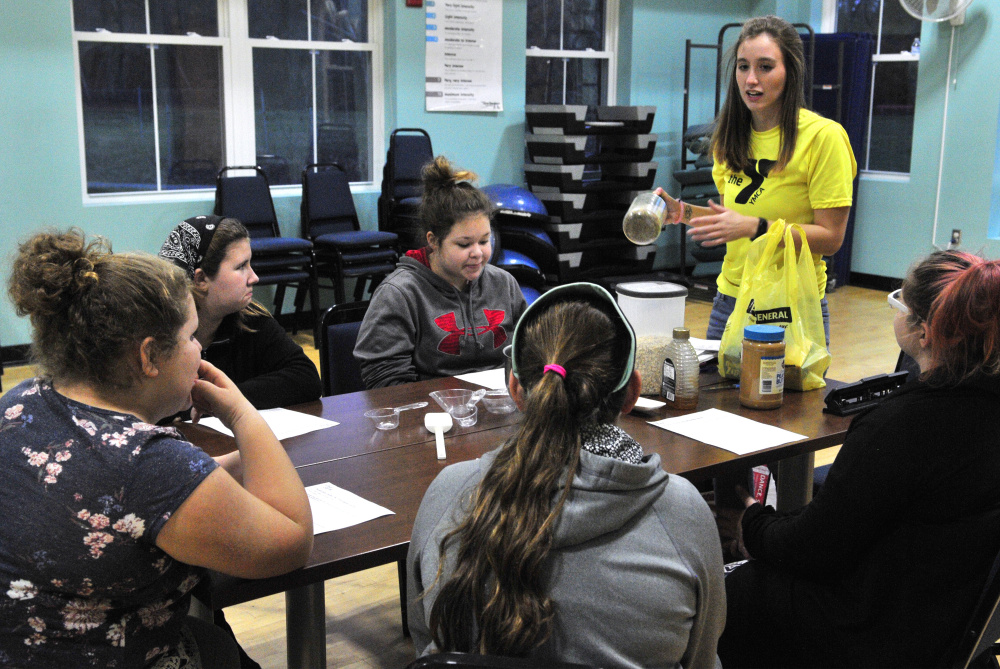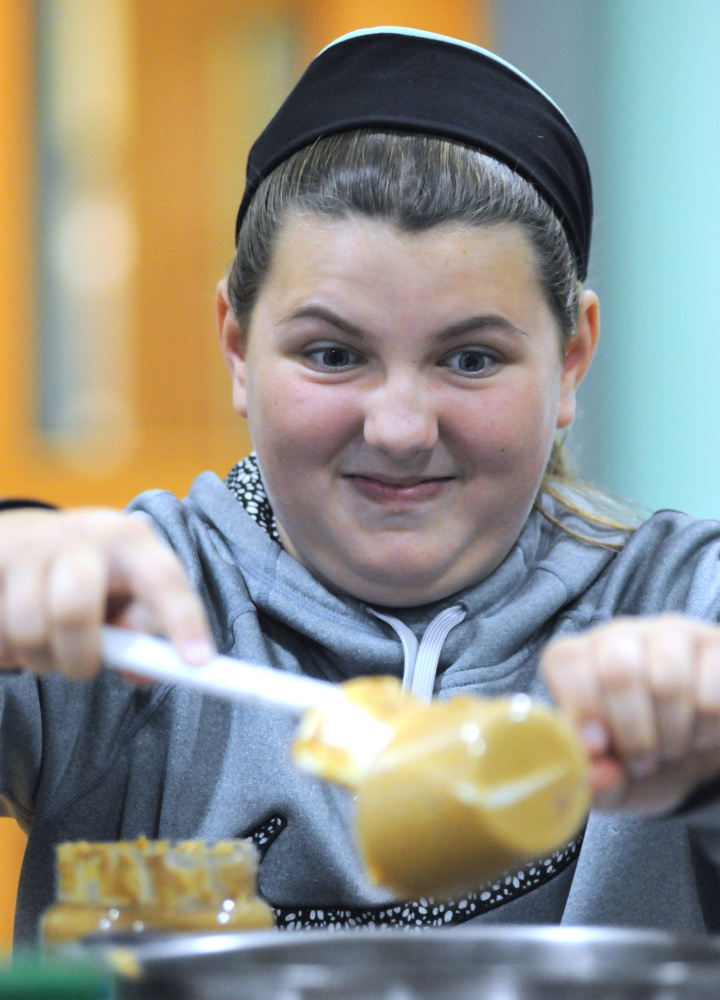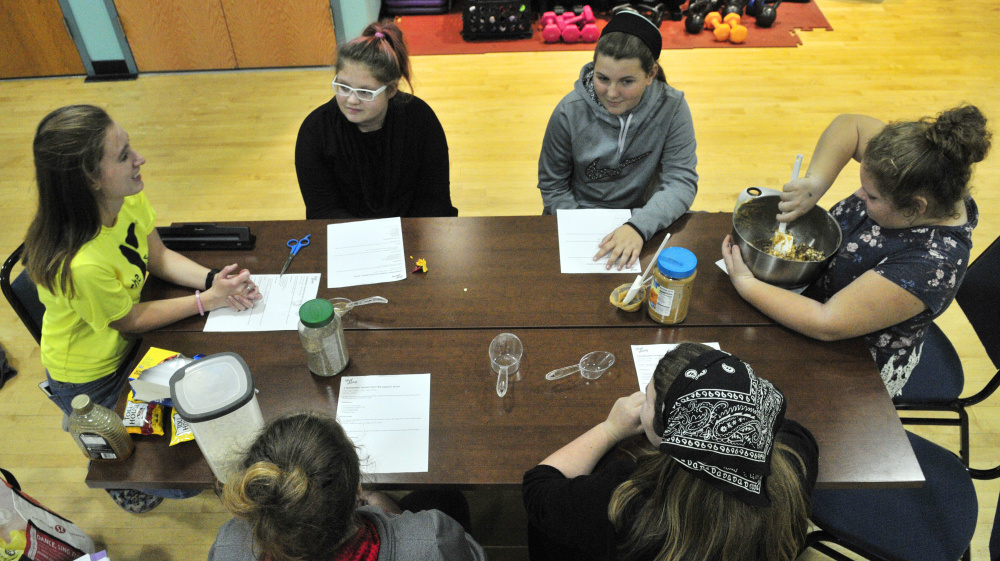AUGUSTA — One by one the five middle-schoolers took turns mixing the ingredients for peanut butter energy bites. First, it was creamy peanut butter and some chocolate chips. Then came a cup of oats, a half-cup of flax seeds and two tablespoons of honey.
After stirring the mixture in a large bowl, the girls washed their hands, rolled the concoction into balls and washed their hands again. It was all part of the first session of the new home economics course being offered at the Kennebec Valley YMCA.
Suzanne Kropp is the program coordinator, and she said while interning at Long Creek Youth Development Center in Portland, she noticed a gap in learning among the teenagers there.
“It’s just not taught anymore (in school), and if you’re not getting the skills at home, where are you getting them?” she said. “They’re basic skills to be useful in life, so this became a passion of mine to connect the gap that’s missing.”
Kropp said the eight enrolled students in the YMCA program will learn life lessons, cooking, sewing, budgeting and how to write a check. The course meets every Tuesday afternoon through Dec. 12, and Mike Griswold, the YMCA’s youth program director, said there is interest in making the course a regular offering.
“We’re going to do a little bit of everything so they can get a foundation (to build on),” Kropp said. “There’s not enough time in their school day to take these electives.”
Crystal Smith’s daughter Jaylynn Strout attends Gardiner Middle School, and she said she enrolled Jaylynn in the course to enhance her abilities and support her interests.
“Jaylynn has her own sewing machine, and I can’t always sit and show her how to do it,” Smith said. “I want her to be able to learn more than the basics in a fun setting.”
When Smith was at Gardiner Middle, she said home economics — now commonly known as family and consumer science — was one of her favorite classes, along with woodshop and metal works. She wished the school districts would bring those classes back.
A Pittsburgh State University study showed a 26 percent decrease in secondary family and consumer science programs since 2003, and Bill Zima, the superintendent of Regional School Unit 2, said school districts working with limited funding had to maximize their returns and prioritize what gets taught.
“With the onset of standardized testing as the sole measure of the effectiveness of education, the priorities became reading and mathematics, so people, money, and time were allocated to bring up the test scores,” Zima said. “This then led to a decline in the number of colleges preparing teachers certified for home economics and industrial arts.”
Susan Turgeson, an assistant professor of family and consumer sciences at the University of Wisconsin-Stevens Point, said as schools focused on core academics and advanced placement, family and consumer science programs were cut because of the misconception that the content taught in those courses weren’t essential to a student’s success.
“The decision-makers failed to recognize the importance of the field and the relevancy to the needs of students,” Turgeson said in a phone interview last week. “Nobody ever leaves a family and consumer science class wondering when they’re going to use (this information) again.”
Heather Turner, whose daughter Madyson Turner and niece Sierra Caulkins are in the program, said the girls learn a lot of this program’s content at home, but many kids don’t have that opportunity.
“In all honesty, knowing how to make a healthy meal and work a budget is just as important, and sometimes more beneficial, than, for example, learning algebra,” Turner said. “I hope this is something we can continue to offer our community.”
Turner said home economics can be a stepping stone to children becoming well-rounded adults, and Zima said schools want students to have the basic skills necessary to properly manage their household.
“If we are clear on what we want students to know and be able to do, we can use the reading, writing and math targets, to help students both practice reading at deeper levels using the content of consumer sciences, while also using math to actually balance a checkbook, apply for the best loan, and manage bills.
“I am happy that our communities are beginning to see the value of a well-rounded person and are asking schools to focus on the whole child,” Zima said.
Turgeson said all people need to be able to manage time, budget money, eat nutritious foods and have positive interaction with other people, and that’s what happens in family and consumer sciences.
“We take it for granted that someone knows how to wash dishes or manage a bank account, but if someone isn’t taught that, they don’t just learn it by osmosis,” she said. Community programs are “wonderful,” she said, but children also need to be taught these skills in school.
Turner hopes any student who takes a home economics course learns skills to better themselves for the future, and she said the lack of understanding of certain basic things she sees daily is cause for concern.
“The amount of people in the U.S. that can’t recognize certain produce let alone know what to do with it, or those who’ve never used a structured budget, is astounding,” Turner said.
Zima said along with time in the school day being limited because of the need to teach to the standardized tests and financial concerns, school districts are having a tough time finding qualified people to teach consumer science classes. Much like with STEM — science, technology, engineering and math — people can make a lot more money working in those fields than a teacher, so finding qualified educators is a challenge.
“We definitely have a teacher shortage, and teaching doesn’t have the same prestige as it had once, and that needs to change,” she said. “Family and consumer sciences is such a springboard for students into so many different career opportunities.”
Without having these skills, Kropp said, some students will be left in a tough position when looking for work whenever their academic pursuits end. Griswold said a lot of people think of the YMCA as a gym and place to swim, but with the KVYMCA’s slogan of “So Much More,” Griswold wants everyone to know what else the organization offers.
“We do after-school programs, we have a pre-school, we offer leadership programs mandated by the national YMCA, and the home economics program is just the newest non-athletic program for us,” he said.
The students will get the opportunity to use the full-size kitchen space throughout the course while learning to prepare healthy meals at home — they’ll keep all their recipes and sewing instructions in a binder.
Griswold and Kropp said the YMCA advertised the course in a youth development brochure, an email blast to members and around the facility.
For more information, visit kvymca.org.
Jason Pafundi — 621-5663
Twitter: @jasonpafundiKJ
Send questions/comments to the editors.







Comments are no longer available on this story